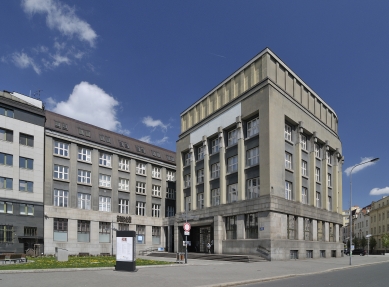
Martin Strakoš: About Karel Kotas, the architect who transformed Moravian Ostrava
Lecture introducing the book Karel Kotas 1894-1973, published by the Municipal House in Brno and the National Heritage Institute.
With the participation of the General Director of the National Heritage Institute Ing. arch. Nadia Goryczková
Architect Karel Kotas arrived in Moravian Ostrava in the spring of 1925 as a building supervisor during the construction of the New Town Hall. In addition to influencing the appearance of this landmark, he soon began to participate in other projects related to the transformation of the Ostrava industrial agglomeration into an industrial metropolis. According to his designs, the Moravian Ostrava Savings Bank grew in the center, now the Town Hall building in the central part of the city, as well as the headquarters of the insurance company Riunione Adriatica di Sicurta at the corner of Zámecká and Puchmajerova streets, the tennis club's headquarters, the Brouk and Babka department store on Smetanovo náměstí, the palace of the Civic Savings Bank in Reálná street, residential buildings of the Workers' Savings Bank in Veleslavínova street, and the Melantrich Palace at the corner of Umělecká and Nádražní streets. He also designed the eye pavilion of the city hospital and the Methodist church chapel. In the late 1930s, he added the palace of the General Directorate of the Northern Railway Ferdinand with remarkable artistic decoration in Prokešovo náměstí and a neighboring apartment building. In his projects, Kotas combined a sense of functionality with an emphasis on material composition, colorfulness, and refined material and spatial composition. He utilized forms of new classicism and purism, enriched with functionalist principles considering the given environment. He paid attention to modern Italian architecture, followed the work of Le Corbusier and other representatives of the artistic and architectural life of the time. He collaborated with artists and engaged in community activities. Apart from Moravian Ostrava, he contributed to the formation of modern Brno, Prague, and the spa town of Teplice nad Bečvou. This year's published monograph on Kotas's lifelong work discusses all these stages of his creation. The introductory lecture by one of the volume's editors will focus primarily on Kotas's Ostrava plans and realizations in the context of architectural development in the 20s and 30s of the last century.
With the participation of the General Director of the National Heritage Institute Ing. arch. Nadia Goryczková
Architect Karel Kotas arrived in Moravian Ostrava in the spring of 1925 as a building supervisor during the construction of the New Town Hall. In addition to influencing the appearance of this landmark, he soon began to participate in other projects related to the transformation of the Ostrava industrial agglomeration into an industrial metropolis. According to his designs, the Moravian Ostrava Savings Bank grew in the center, now the Town Hall building in the central part of the city, as well as the headquarters of the insurance company Riunione Adriatica di Sicurta at the corner of Zámecká and Puchmajerova streets, the tennis club's headquarters, the Brouk and Babka department store on Smetanovo náměstí, the palace of the Civic Savings Bank in Reálná street, residential buildings of the Workers' Savings Bank in Veleslavínova street, and the Melantrich Palace at the corner of Umělecká and Nádražní streets. He also designed the eye pavilion of the city hospital and the Methodist church chapel. In the late 1930s, he added the palace of the General Directorate of the Northern Railway Ferdinand with remarkable artistic decoration in Prokešovo náměstí and a neighboring apartment building. In his projects, Kotas combined a sense of functionality with an emphasis on material composition, colorfulness, and refined material and spatial composition. He utilized forms of new classicism and purism, enriched with functionalist principles considering the given environment. He paid attention to modern Italian architecture, followed the work of Le Corbusier and other representatives of the artistic and architectural life of the time. He collaborated with artists and engaged in community activities. Apart from Moravian Ostrava, he contributed to the formation of modern Brno, Prague, and the spa town of Teplice nad Bečvou. This year's published monograph on Kotas's lifelong work discusses all these stages of his creation. The introductory lecture by one of the volume's editors will focus primarily on Kotas's Ostrava plans and realizations in the context of architectural development in the 20s and 30s of the last century.
The English translation is powered by AI tool. Switch to Czech to view the original text source.



0 comments
add comment










